Nutrition can be a touchy subject. It’s important to educate yourself and find what works for you and your dog.
– Furry Logic Dog Training
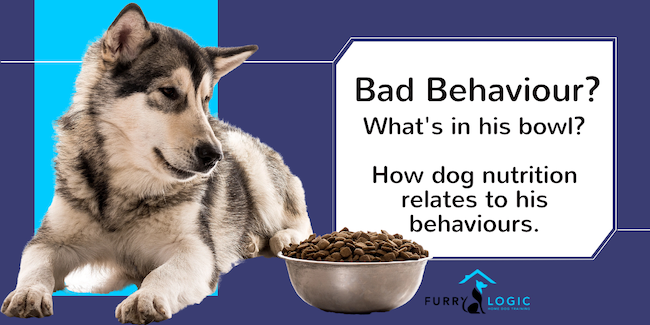
What should I feed my dog?
At Furry Logic Home Dog Training, we are often asked about what food our clients “should” be feeding their dogs.
We are grateful that our clients think highly of our knowledge enough to ask US for advice on this topic. It’s not an easy question to answer because there isn’t ONE dog food that’s the BEST for every dog. There are many things to consider when it comes to making a choice about what food to feed your dog.
Dog food can be a touchy subject and there are many options. Some options include canned food, raw food diets and dry kibble diets. It’s important to educate yourself and find what works for you and your dog. This article is focused on dry kibble diets as it’s the most common feeding choice for dog owners. Look for other articles about other diet types on our blog in the future.
We do know that feeding a good quality food can contribute and in some cases even eliminate problem behaviours in dogs. For example, if you or your vet think your dog is overweight, you might need to consider a weight loss program, and you may be feeding a “diet” or “light” dog food. We had one such client who we helped in this situation and one of the behavioural troubles they were looking for guidance on was aggression.
When we evaluated the ingredients list of the food they were feeding their dog, we noticed that the quality of the fibre in the brand they fed was a very low quality source of fibre. Consequently, the dog never felt satiated and was constantly hungry, leading to aggressive behaviours.
We as humans all know that we “are what we eat” and having a well balanced, nutritious diet leads to healthier outcomes. The same is true for our pets. We also know that when it comes to dog food, there are many choices with a wide range of varying prices and it can be difficult to choose the right food for your dog. And we are bombarded by marketing which makes us feel better about some brands than others.
At the end of the day, as pet owners, our work is really cut out for us and it’s important to be able to decipher pet food labels and nutritional analysis panels in order to make an informed choice. There are some important considerations before you make your choice:
- Consult with your veterinarian – your vet can help make sure your dog is healthy and has no concerns which can be affected by diet such as UTI’s or kidney problems. There are some dogs who require prescription diets and your vet is the best person to help you decide the most appropriate food for your dog in those situations
- If your dog is otherwise healthy, other factors such as age, breed and activity levels will help determine which type of food you should feed. Large breed dogs dietary requirements are much different that small breed based on their digestive structure alone.
- Budget can play a large role in your decision. – Let’s face it, everything seems to cost a lot these days, and dog food is no exception. You should feed the best food you can afford without sacrificing nutritional quality for your dog or your own family grocery budget.
Pet Food Standards in Canada
We have minimal laws regarding labelling in Canada when it comes to pet foods. There are only 4 actual requirements – product identity, net quantity, manufacturers and dealers name and address and the label must be in English and in French. That’s it! Even though we don’t have any governing body overseeing labelling standards, thankfully we voluntarily (for the most part) follow the AAFCO standards set out in the United States.
Reading a dog food label to find out how dog food is made
We are often greeted with images of whole fresh chickens and ‘feel-good’ statements
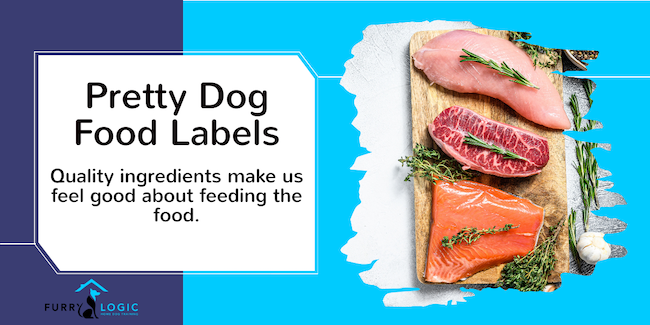
The dog food industry in Canada is estimated to be worth more than $2B USD in 2021 and is consistently growing. Manufacturers conduct marketing studies and find the best ways to make us feel good about their foods and keep us feeding them to our dogs. It can be difficult to see past this marketing when we’re in a hurry and looking strictly at price tags.
In Canada we follow the AAFCO standards when it comes to labelling dog foods and there are certain terms we’ll see which have legal definitions such as
- Organic – defined as containing ingredients which have not been chemically altered or treated
- Natural – defined as having no chemical alterations except for the addition of vitamins and minerals
It’s important to note that “Holistic” has no legal definition and that “Human Grade” is not allowed on a pet food label (their websites are another story, but we are speaking in terms of pet food packaging here.)
Most of these terms are coined and used in order to make us feel good about feeding a particular food to our dog. But the more important information that we need to pay attention to resides on the back and side panels of the dog food.
Time to flip the bag over – what should I look for in a dog food?
The ingredients panel (along with the guaranteed analysis panel) can give us some very important information about the quality of the food we are feeding our dogs. The same is true as we say for ourselves: “we are what we eat.”
Like us, dogs require protein, carbohydrates and fats & oils in their diets in order to survive and thrive. Just like us, the quality of those dietary elements is everything. We CAN eat drive thru takeout every single day for a considerable amount of time, but eventually that type of diet can take its toll on our bodies. It’s obviously beneficial to our health and our dog’s to be fed a balanced and nutritious diet.
There are many different sources for dogs to receive protein, carbs and fats in their diet and they are not created equally!
When we look at dog food labels, it’s really the first 5-8 ingredients which provide the majority of the nutrition in a dog food. Pet food labels list their ingredients in order by weight from most to least. So the first ingredient in the list is the one they’ve used the most, by weight in its raw form, to make the food. Second, third, fourth and fifth by weight follow.
In a healthy, balanced food, those first few ingredients should be good sources of protein, carbohydrates and good quality fats. After that, you’ll see the addition of other ingredients which may be things such as preservatives, flavours and spices and maybe even minerals and vitamins.
The further down the list of ingredients, the less of that ingredient was used to make the food. So you can assume that as you get to the end of the list, by volume, the last few ingredients are probably pretty negligible amounts.
Protein – It’s why dog food is expensive
Protein can be sourced from animals or plants. Protein is required to build and maintain muscle and maintain heart function. Although a dog can survive on a plant based protein, unless it is recommended by your vet for a health reason, is generally not advisable.
In recent years, there has been a movement towards feeding unique and novel protein diets because they are thought to be possibly less risk of allergic reaction as a protein source. Sources such as duck or antelope are thought to be less allergenic because dogs have had less exposure to them and therefore there would be lower risk of allergic reaction or perceived sensitivities.
The most easily digested and easily bioavailable source of protein is eggs. And although it may be the perfect protein source, it wouldn’t be economically feasible for dog food brands to put whole, fresh eggs as a primary protein source (imagine the dozens of eggs in each bag of dog food and how pricey it would be!)
The next best bioavailable protein source is chicken. This becomes a very affordable source of protein in pet foods when you consider the use of hearts and gizzards from the human poultry industry (which would otherwise be wasted) that are turned into chicken by-product meal – dried and ground, concentrated and high protein.
Chicken and chicken by-products are some of the most common ingredients you’ll find on a dog food label.
Frequently dog foods will use chicken meal or some other kind of meat meal as a primary source of protein. The ‘meals’ are simply dried meat that’s been ground into a meal powder (think like a spice shaker of poultry seasoning) and is a very cost-effective protein source (because you’re not paying for the water weight of the chicken.) You may even see ‘chicken by-product meal’– don’t let the term “by-product” scare you.
You’ve more than likely had your fair share of by-product. Ever eaten a wiggly fun cup of Jello? This is one example of a by-product – “a secondary product made in the manufacture or synthesis of something else.” Jello contains gelatin – a by-product of rendering collagen and bone marrow from beef bones and skin.
There are rules about what can be contained in these by-products. For example, no feathers are allowed in chicken by-product meal, however some bone and carcass are permitted. This may contribute to higher calcium and phosphorus levels. When ‘meat meal’ is listed on the label, it usually comes from beef and is NOT allowed to contain hair, hoof, hide or rumen.
Chicken meal is most commonly used because of its high protein and lower levels of calcium and phosphorus. Generally it uses less bone and carcass content and by rule of its AAFCO definition cannot contain feathers, heads, feet, entrails, etc. It’s ‘basically’ the same parts of the chicken we would eat on our dinner table, but dried and ground into a meal to maintain its nutritional value.
Finding dog food without chicken is no easy task. It seems to be in most mainstream and grocery brands, even in small amounts. If you’re concerned about allergies, you may need to find a special limited ingredient diet in order to avoid certain ingredients.
Carbohydrates
Carbs are used by your dog’s body for quick energy. Just the act of living requires energy and carbohydrates. Carbs are either burned and used up or they are stored for later if they aren’t used.
If you have a large breed, high energy dog, it’s apt to burn a lot of carbs just living his happy dog life. If he’s living his best life (all the exercise, play time and walks a dog could wish for,) he’ll require more good quality carbs to keep the furnace burning than a small inactive dog would!
We all know (don’t we?) – all carbs are not created equally!
Strawberries have carbs and so does ice cream. Which would be the better (*clears throat -ahem*, healthier) carb choice between those two? Just like our own dietary choices can impact our health, the same is true for dogs. A diet too high in carbs (i.e.: grains) has the potential to lead to health issues such as insulin resistance, causing a cascade effect of other health conditions such as thyroid and heart problems.
Fibre takes longer for the dog’s body to digest and gives them a feeling of fullness. When looking at an ingredient panel and comparing a regular dog food to one labelled as “light” (which is only in comparison to their own regular brand of food,) one of the first things you’ll notice is the fibre content in the light food is considerably higher than in the ‘regular’ food of their brand.
This helps the dog feel fuller for a longer period of time. Since there are fewer calories in the food for the dog’s body to burn, the fibre increase helps him feel he’s full. In a ‘light’ food, you may see fibre sources such as peanut hulls (low quality) or fresh whole pumpkin (higher quality) which are added to the food. Remember, whatever their body doesn’t burn flows right through them and into your back yard in the form of pet waste. So choose your fibre sources wisely!
A Note About Carbs and Grain Free Dog Foods
A dog can survive without carbs in their diet, and in recent years, there has been a movement towards feeding grain-free diets. However, there have been some recents studies which show some breeds are prone or predisposed to heart issues and research is pointing to grain free diets as a potential cause for the cardio issues. PetMD has written a great article about grain free diets and some of the research related to DCM (Dilated Cardiomyopathy) and what breeds are more prone to this health concern. And the AKC reports that the FDA is investigating grain free dog foods for the very same reason.
Not all grains are bad for dogs. Grains such as corn do have protein as well as carbohydrates, Omega 3 and Omega 6 fatty acids and do come with health benefits. Some grains used as protein sources in dog food help control the final cost of the food, meaning a lower price tag for you as the consumer.
It is best to consult with your veterinarian before changing your dog’s diet and have them help you weigh the risks and benefits of a grain free diet for your dog.
Fats & Oils
Good sources of fats and oils play an important part in your dog’s diet. They provide energy sources, help with skin and coat and also may help naturally preserve the food from spoilage. They also add flavour to the food, making it more palatable (to them)! Have you ever tasted your dog’s kibble? Strongly do NOT recommend!)
You’ll often see tocopherols mentioned on a pet food label (a natural preservative that comes from vegetable oils, nuts and seeds, a.k.a.: vitamin E) as well as chicken fat and vegetable oils listed as fat sources on a dog food label. These help deliver essential fatty acids necessary for healthy skin and coat.
One of the first things dog owners usually notice when their dog “goes on a diet” is that he seems itchy and his coat loses its shine. This is because in the calorie cutting process of diet dog foods, one of the first things to cut calories is to limit the amount of fats in the food. If this is the case for you, make sure to discuss alternatives or supplements with your vet.
Comparing Three Popular Brands Based on Labels
So, now that we know a bit about what each of the dietary needs are in the food, let’s take a look at some pet food labels and look for some good sources of each based on the ingredients lists.
We’ve chosen 3 popular brands of ‘light’ dog foods to compare so that it was easier to compare the food quality.
One of the concerns our clients have is often with aggression and when we investigate diet as a contributing factor to aggression using these three brands as a comparison tool, we can quickly see why the dog might behave with aggression — he’s probably HANGRY!

When we compared three brands, we looked at a grocery store shelf brand, a very popular mainstream brand and a “boutique” brand of pet food. We compared protein, carb and fat sources as well as the nutritional analysis to try to get a picture of which brand might be best. We also calculated the cost to feed a German Shepherd for a month on each brand.
It was a difficult comparison because none of the brands had any “bad ingredients”, per se. All the ingredients bring nutritional value to the label and any dog could eat these diets and survive just fine.
However, as we looked at each ingredient label, it was easy to see the standout ingredients and which ones were more than likely healthier for our dogs. We also compared calories and boy, is it easy to see why a dog could still gain weight on a “diet food”! And we could also easily predict which brands would have us out in the backyard cleaning up more often than we’d like to!
Pricing was a little deceiving because if you evaluate the price per cup, Brand B should win over Brand C, however since their feeding guidelines were higher for our 70 pound German Shepherd, they ended up being more expensive over the course of a month. Brand B also had the lowest calories of all compared.
The least expensive brand was almost HALF THE PRICE compared to the popular mainstream brand! You could definitely tell that their choice of protein sources had a huge impact on pricing. The unfortunate thing about Brand A is that the recipe of the food will probably frequently change because of market pricing and availability of those less-expensive protein sources. So you may find your dog “turning up his nose” if he’s a picky eater that’s sensitive to change.
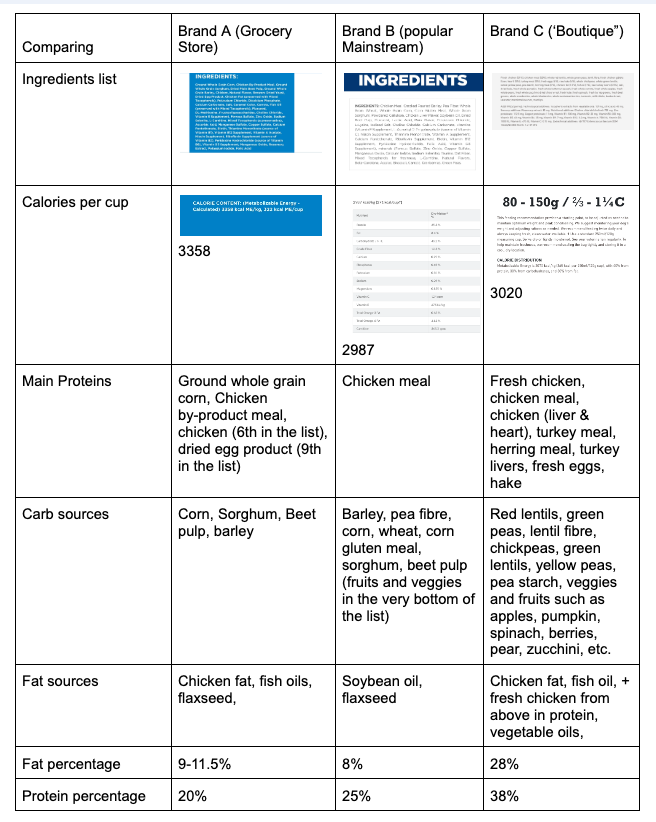
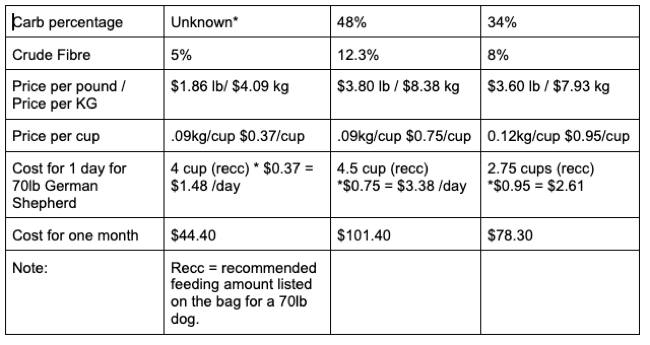
The bottom line?
Based on the value per cup, the list of ingredients being pronounceable and good quality, we know our dog is going to need to eat less of Brand C and even though it seems pricey up front at 95 cents per cup, his body will make use of the ingredients and less mess to clean up in the yard.
Although Brand A initially had the most appeal because of sticker price, we had concerns with the amount of grain and the fact that they don’t show the percentage of carbs in the food. We *could calculate that but, who does that standing around at the dog food aisle? Also, they were missing a key piece of information on their label for us to calculate that using a standard formula. We did an estimate calculation to determine it’s around 47.5% carbohydrates but suspect it’s actually higher.
*Calculate carbohydrate content: Add protein, fat, fibre, moisture, and ash, and subtract that sum from 100. If ash is not listed, estimate 2% for wet food and 6% for dry food.1
The Head to Head Comparison of Labels
Brand A 2

Brand B 3
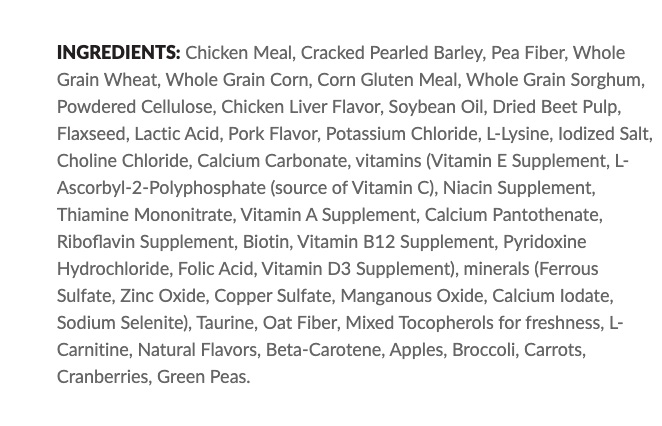

Brand C 4
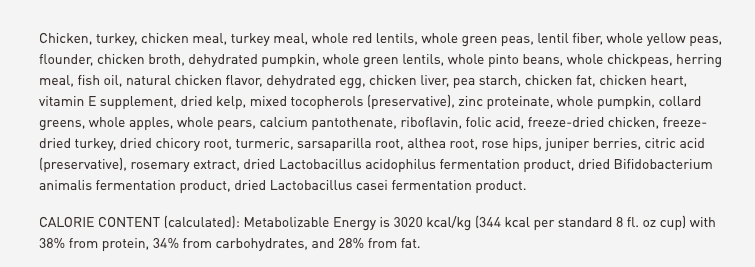
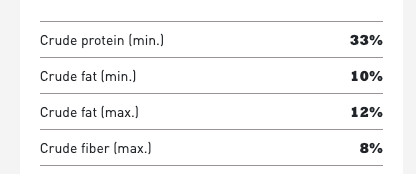
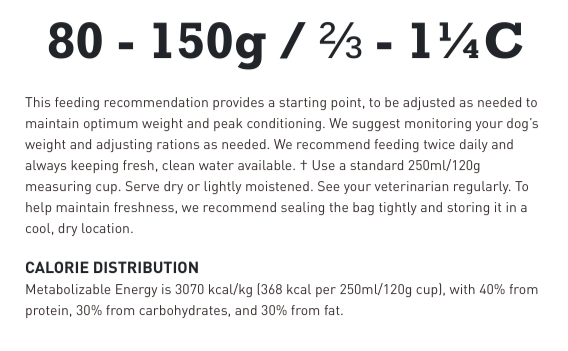
Behaviours That Can be Influenced or Impacted by Your Dog’s Diet
When your dog is hungry, he may exhibit the following undesirable behaviours:
- Aggression
- Scavenging
- Stealing food
- Breaking into the garbage
- Resource guarding
- Moodiness
- Reactive behaviour
- Fighting with other dogs in the home
Other behaviours which could be related to diet:
- Coprophagia
- Digging
- Chewing non-food items such as wood or rocks
- Eating quickly and then vomiting
- Hyperactivity
- Inability to focus
- Lethargy
- Urinary incontinence
It’s important to address any health concerns you have for your dog with your vet. Your vet can guide you on the appropriate dietary solutions for health concerns. Once that’s ruled out, you may need to consider altering your dog’s diet as part of your behaviour adjustment plan.
Remember when changing diets, it’s important to GRADUALLY switch foods
If you have decided to make a change, be sure to plan ahead and have at least a few weeks of the old food left for transitioning. Begin by mixing in 10-20% of the new food for the first week, 30-50% of the new food with the old food for the second week and then in week three you can work your way up to 100% of the new food. This will allow your dog’s digestive system the time it needs to adjust, especially if introducing a different primary protein source.
When considering your dog’s behavior, it is essential to evaluate their diet. Your vet can provide guidance on suitable dietary solutions, and if necessary, making gradual changes to their food may be part of your behavior adjustment plan. Remember to plan ahead and transition slowly when switching diets.
Need Help Finding a Good Dog Food?
You have lots of choices! Here’s a few of our favorite pet nutrition experts that we know and trust to help guide our clients:
- Tail Blazers
- Global Pets
- Atomic Dog Boutique
Need help with behaviour therapy? Furry Logic Home Dog Training is here whenever you need us. Book your lesson package today.
Footnotes
- A quick Google search result on August 29, 2024: https://www.google.com/search?q=calculate+carbohydrate+percentage+in+dog+food
↩︎ - Brand A: Iams – Iams Adult Healthy Weight Control Dry Dog Food with Real Chicken – screen shot taken from Walmart website on August 29, 2024
↩︎ - Brand B – Hill’s Science Diet Adult Light Dry Dog Food, Chicken Meal & Barley – screenshots taken from Amazon website and Hill’s website August 29, 2024
↩︎ - Brand C – Acana Light & Fit Recipe – Screenshots taken from Acana website and PetValu website August 29, 2024
↩︎





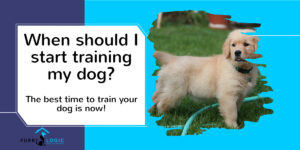

No comment yet, add your voice below!